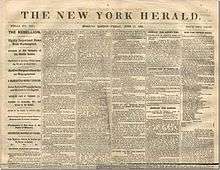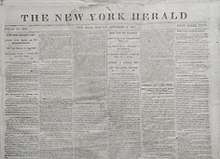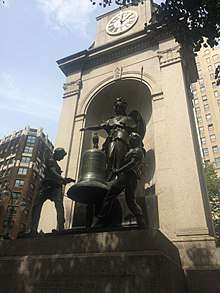New York Herald
The New York Herald was a large-distribution newspaper based in New York City that existed between 1835 and 1924, when it merged with the New-York Tribune to form the New York Herald Tribune.
 Cover of New York Herald on June 20, 1861, covering news of the American Civil War | |
| Type | Daily newspaper |
|---|---|
| Format | Broadsheet |
| Publisher | James Gordon Bennett, Sr. James Gordon Bennett, Jr. |
| Founded | 1835 |
| Ceased publication | 1924 |
| Headquarters | Manhattan |
| Circulation | 84,000 (1861) |


History

The first issue of the paper was published by James Gordon Bennett, Sr., on May 6, 1835. By 1845, it was the most popular and profitable daily newspaper in the United States.[1] In 1861, it circulated 84,000 copies and called itself "the most largely circulated journal in the world."[2] Bennett stated that the function of a newspaper "is not to instruct but to startle and amuse."[3][4] His politics tended to be anti-Catholic and he had tended to favor the Know-Nothing faction, though he was not particularly anti-immigrant as the Know-Nothing party were. During the American Civil War, his policy as expressed by the newspaper was to staunchly support the Democratic Party. Frederic Hudson served as managing editor of the paper from 1846 to 1866.
Bennett turned over control of the paper to his son James Gordon Bennett, Jr. in 1866. Under Gordon Bennett Jr., the paper financed Henry Morton Stanley's expeditions into Africa to find David Livingstone, where they met on November 10, 1871.[5] The paper also supported Stanley's trans-Africa exploration, and in 1879 supported the ill-fated expedition of George W. DeLong to the arctic region.
In 1874, the Herald ran the New York Zoo hoax,[6][7] where the front page of the newspaper was devoted entirely to a fabricated story of wild animals getting loose at the Central Park Zoo and attacking numerous people.
On October 4, 1887, Bennett Jr. sent Julius Chambers to Paris, France to launch a European edition. Bennett himself later moved to Paris, but the New York Herald suffered from his attempt to manage its operation in New York by telegram. In 1916 a Saturday issue of the paper reported that a major financier was found dead poisoned, and then added that in 1901 he was "mysteriously poisoned and narrowly escaped death."[8]
In 1924, after Bennett Jr.'s death, the New York Herald was acquired by its smaller rival the New York Tribune, to form the New York Herald Tribune. In 1959, the New York Herald Tribune and its European edition were sold to John Hay Whitney, then the U.S. ambassador to the UK. In 1966, the New York paper ceased publication. The Washington Post and The New York Times acquired joint control of the European edition, renaming it the International Herald Tribune. The IHT, renamed The New York Times International Edition, is now wholly owned by The New York Times.[9]
When the Herald was still under the authority of its original publisher Bennett, it was considered to be the most invasive and sensationalist of the leading New York papers. Its ability to entertain the public with timely daily news made it the leading circulation paper of its time.
Evening Telegram
The New York Evening Telegram was founded in 1867 by the junior Bennett, and was considered by many to be an evening edition of the Herald. Frank Munsey acquired the Telegram in 1920, which ceased its connection to the Herald.[10]
Commemorated

New York's Herald Square is named after the New York Herald newspaper;[11] in the north side of the square is a sculpture commemorating the Bennetts. The statue of Minerva, the Bellringers, and Owls by Antonin Carles originally graced the New York Herald building and rang every hour until it was moved to Herald Square. The chorus of Give My Regards to Broadway includes the phrase "[R]emember me to Herald Square." North of Herald Square is Times Square, which is named after rival The New York Times.
See also
- Porter Cornelius Bliss
- New York Herald Tribune (successor to the New York Herald)
References
- Crouthamel, James (1989). Bennett's New York Herald and the Rise of the Popular Press. Syracuse University Press.
The finished four-page Herald with its circulation of twelve thousand as in 1845 the most popular and profitable daily newspaper in the United States. Its niche was so secure that its success seemed almost inevitable. But Bennett was fifty years old, and his success had come very late, after many years of apparent failure. ...
- Sandburg, Carl (1942). Storm Over the Land. Harcourt, Brace and Company. p. 87.
- Katherine Roeder (March 25, 2014). Wide Awake in Slumberland: Fantasy, Mass Culture, and Modernism in the Art of Winsor McCay. Univ. Press of Mississippi. pp. 28–. ISBN 978-1-62674-117-1.
- New Outlook. Outlook Publishing Company, Incorporated. 1892. pp. 489–.
- Carey, John (March 18, 2007). "A good man in Africa ?". The Sunday Times. Retrieved November 15, 2007.
His quest to find David Livingstone was financed by his paper, the New York Herald. Nothing had been heard of the great explorer since the previous year, when he was somewhere on Lake Tanganyika.
- Robert E. Bartholomew; Benjamin Radford (October 19, 2011). The Martians Have Landed!: A History of Media-Driven Panics and Hoaxes. McFarland. pp. 84–85. ISBN 978-0-7864-8671-7.
- Connery, T. B. (June 3, 1893). A Famous Newspaper Hoax, Harper's Weekly, p. 534
- "Jacques S. Halle dies". New York Herald. December 2, 1916. p. 5.
- Doreen Carvajal (June 24, 2008). "The Times and I.H.T. Study Web Merger". The New York Times.
- "The Telegram Sold to Scripps-Howard". The New York Times. February 12, 1927.
- Eve Zibart (2010). The Unofficial Guide to New York City. p. 1678. ISBN 0470637234.
External links
- The New York Herald 1842-1920 Many Editions Digitized Online at The Library of Congress
- Three months with the New York Herald: or, Old news on board of a homeward ... by John Henry Potter
- Photographs and architectural sketches of the New York Herald Building
- A winter evening in a crowded Herald Square at the New York Herald Building, oil on board painting